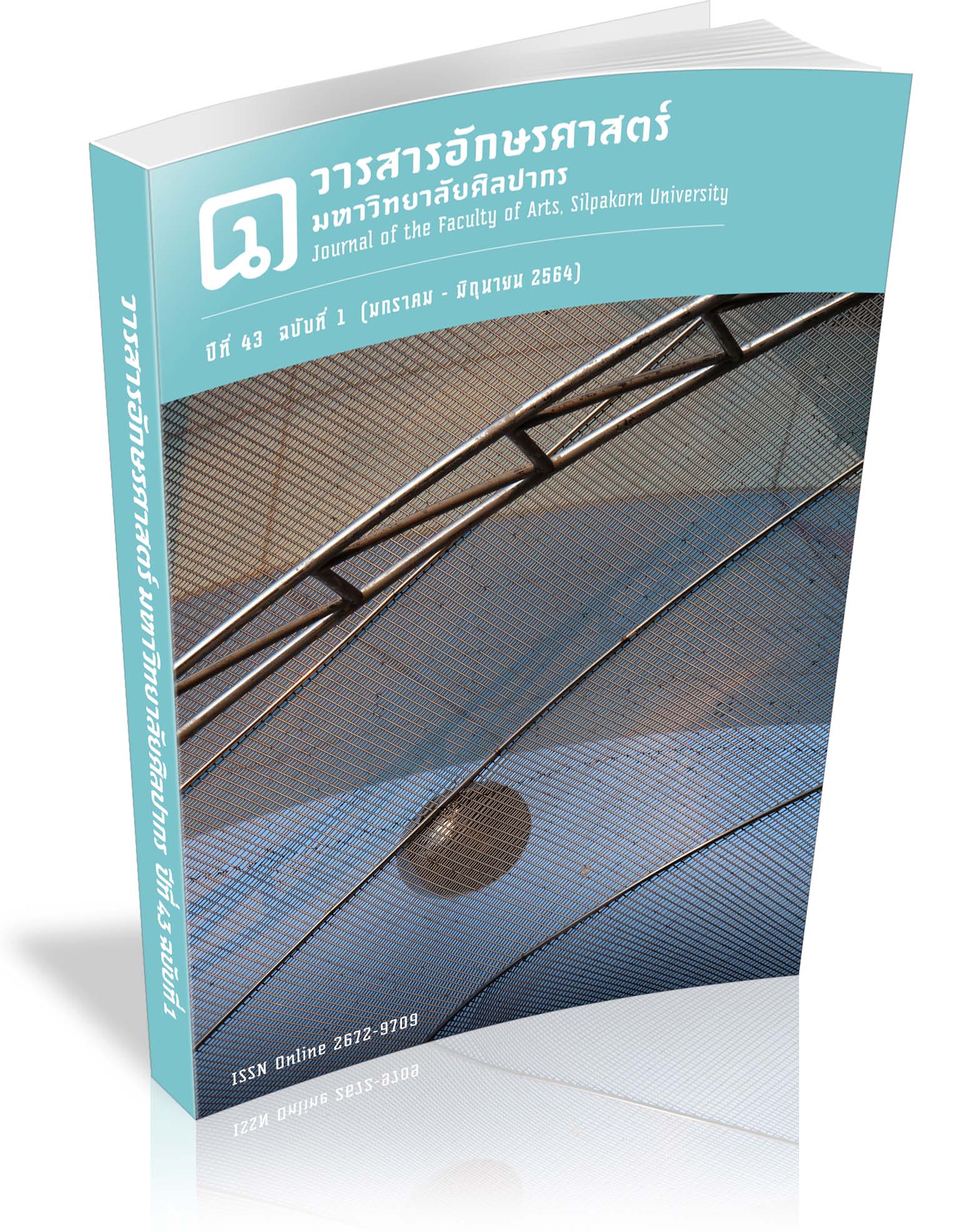อนุภาค AN (أنْ) ในประโยคย่อยซ้อนความภาษาอาหรับ: เส้นทางการเปลี่ยนแปลง
คำสำคัญ:
ภาษาอาหรับ, ตัวนำส่วนเติมเต็ม, ประโยคย่อยซ้อนความบทคัดย่อ
บทความชิ้นมุ่งวิเคราะห์พัฒนาการของอนุภาค AN (أنْ) ในประโยคย่อยซ้อนความภาษาอาหรับ ทั้งนี้เพราะแนวการวิเคราะห์ที่ผ่านมาทั้งในทฤษฎีไวยากรณ์อาหรับดั้งเดิม และกรอบวิเคราะห์ในภาษาอาหรับมาตรฐานสมัยใหม่ ยังไม่สามารถอธิบายโครงสร้างที่เกิดขึ้นของอนุภาค AN ในประโยคย่อยซ้อนอย่างเป็นระบบได้ ดังนั้น ผู้เขียนจึงพยายามนำเสนอพัฒนาการของอนุภาค AN โดยเริ่มจากปรากฏในรูปแปรแบบหนึ่งของประโยคความซ้อนในภาษาอาหรับยุคก่อนคลาสสิก ต่อมากลายเป็นตัวบ่งชี้หน่วยนามวลีแปลงในภาษาอาหรับคลาสสิกและกลายเป็นตัวนำส่วนเติมเต็มในภาษาอาหรับมาตรฐานสมัยใหม่ จนในที่สุดกลายเป็นหน่วยอิสระใหม่โดยควบรวมกับกริยาและบุพบทที่ปรากฏร่วมกันบ่อย พัฒนาการดังกล่าวสามารถใช้อธิบายรูปภาษาที่ตกค้างในขั้นตอนพัฒนาการต่างๆ ซึ่งเป็นสาเหตุที่ทำให้การวิเคราะห์ที่ผ่านมาไม่สอดคล้องกัน
Downloads
เอกสารอ้างอิง
Abu-chacra, F. (2007). Arabic: An Essential Grammar. Oxon: Routledge.
Al-ghaylāyyinī, M.(2003). Jāmiʿa l-durūs l-ʿaarabīyah. Al-maktabat al-assrya: Sidon-Beirut.
Anghelescu, N. (1999). Modalities and Grammaticalization in Arabic. In Y. Suleiman (Eds.), Arabic Grammar and Linguistics. Oxon: Routledge p. 107-142
Aoun J. E., Choueiri L. & Benmamoun E. (2010). The Syntax of Arabic. London: Cambridge University Press.
Ayed, H. B. (2003). Mood and functional projections. Ph.D. diss., McGill University.
Badawi, A. E. E.-S. M. (1996). Understanding Arabic Essays in Contemporary Arabic Linguistics in Honor of El-Said M. Badawi. Cairo: the American University in Cairo Press
Belnap, R. K. (1986) Grammar, Style and Discourse: An Empirical Look at Modern Satandard Arabic Complementation in the Newspaper, Al-Ahram. Deseret Language and Linguistic Society Symposium: 12 (1), Article 5.
Bybee, J. (2003). Mechanisms of Change in Grammaticalization: The Role of Frequency. In B. D. Joseph & R. D. Janda (Eds.), The Handbook of Historical Linguistics. (pp. 602-623). USA: Blackwell Publishing.
Bybee, J. (2007). Sequentiality as the Basis of Constituent Structure. In J. Bybee (Ed.), Frequency of Use and the Organization of Language (pp. 313-335). New York: Oxford University Press.
Cantarino, V. (1975). Syntax of modern Arabic prose. Bloomington / London: Indiana University Press
Dar l-maʿrifah, Al-Quran l-kareem. (2000). Rakābi wa Naḍr Publishing: Damascus-Syria.
Dixon, R. M. W. (2006). Complement Clauses and Complementation Strategies in Typological Perspective. Complementation: A Cross-Linguistic Typology, . A. Y. A. R. M. W. DIXON. New York: Oxford University Press.
Fischer, W. (1972). Perioden: “Die Perioden des klassischen Arabisch”. In: Abr Nahrain XII. Leiden: E. J. Brill. pp. 15–18.
Fischer, W. (1978). “Dass-Sätze mit AN und ANNA In: Zeitschrift für arabische Linguistik .I Wiesbaden: Harrassowitz. pp. 24–31.
Genetti, C. (2011). Nominalization in Tibeto-Burman languages of the Himalayan area: A typological perspective. Nominalization in Asian languages: diachronic and typological perpsectives. K. G.-H. Foong Ha Yap, Janick Wrona, p. 163-194.
Grunow-Harsta, K. (2011) Innovation in nominalization in Magar, a Tibeto-Burman language of Nepal. Nominalization in Asian Languages: Diachronic and typological perspectives. K. G.-H. Foong Ha Yap, Janick Wrona. Amsterdam / Philadelphia, John Benjamins Publishing Company, p. 215-254.
Haywood, J. A. & Nahmad, H. M. (1965). A New Arabic Grammar of the Written Languge. London: Lund Humphries.
Holes, C. (2004). Modern Arabic: Structures, Functions, and Varieties. Washington D.C.: Georgetown University Press.
Ibn ʿaqīl, B. ʿA. (2002). sharḥ Ibn ʿaqīl. Vol.2. Al-maktabat al-assrya: Sidon-Beirut.
Ibn l-ḥājib, R.M. (1998). Sharḥ ibn l-ḥājib. Vol.4. Dar al-Kotob al-ilmiyah-Beirut: Lebanon.
Ibn hishām, Abdullah jamāluddīn. (2005) Mughī l-labīb ʿan kutub l-aʿārīb. Dār l-ṭalāʾiʿ: Cairo
Ibn l-sarrāj, muḥammad ibn sahl. (1999). l-uṣūl fī l-naḥw. Vol.2 Al-risalah plublisher: Lebanon-Beirut.
l-dasūqī, Musṭāfā Muḥammad. (2000). ḥāshiyah l-dasūqī ʽalā mughnī l-labīb. Vol.1. Dar al-Kotob al-ilmiyah-Beirut: Lebanon.
Lichtenberk, F. (2011). Nominalizations in Toqabaqita and closely related languages. Nominalization in Asian Languages: Diachronic and typological perspectives. K. G.-H. Foong Ha Yap, Janick Wrona. Amsterdam / Philadelphia, John Benjamins Publishing Company, p. 685-720
Moran, W.L. (1960) Early Canaanite yaqtula. Orientalia, Vol. 29, No. 1, pp. 1-19
Naknawa, D. (2017). The Proportion of Occurrences of Templatic Maṣdar and Periphrastic Maṣdarin Modern Standard Arabic: A Diachronic Study. Humanities Journal. No.24, Vol.1 (January-June), Kasetsart University. p. 327-374.
Noonan, M. (2006). Complement Clause. Encyclopedia of Linguistics. E. K. Brown, R. E. Asher, J. M. Y. Simpson. Elsevier. 2, p. 694-967
Noonan, M. (2011) Aspects of the Historical Development of Nominalizers in the Tamangic Languages. Nominalization in Asian Languages: Diachronic and Typological Perspectives. K. G.-H. Foong Ha Yap, Janick Wrona (Eds). Amsterdam / Philadelphia, John Benjamins Publishing Company, p. 195-214.
Office of the Royal Society, (2017). Dictionary of Linguistic Terms (General Linguistics). Bangkok: Art Department.
Persson, M. (1999). Semantic Consideration in the Sytactics Structures of Complement Clauses in Modern Standard Arabic. In Y. Suleiman (Ed.) Arabic Grammar and Linguistics. Oxon: Routledge, p. 182-202.
Post, M. W. (2011). Nominalization and nominalization-based constructions in Galo. Nominalization in Asian Languages: Diachronic and typological perspectives. K. G.-H. Foong Ha Yap, Janick Wrona (Eds). Amsterdam / Philadelphia, John Benjamins Publishing Company, p. 255-288.
Rabin, C. (1951) Ancient West-Arabian: A Study of the Dialects of the Western Highlands of Arabia in the Sixth and Seventh Centuries A.D. London: Taylor’s Foreign Press.
Reckendorf, H. (1921). Arabische Syntax. Heidelberg: Carl Winter’s Universitätsbuchhandlung.
Ryding, K. C. (2005). A Reference Grammar of Modern Standard Arabic. UK: Cambridge University Press.
Sadan, A. (2012) The Subjunctive Mood in Arabic Grammatical Thought. Brill: Leiden-boston Schulz, E. (2004). A Student Grammar of Modern Standard Arabic. UK: Cambridge University Press.
Shlonsky, U. (1996). Remarks on the Complementizer Layer of Standard Arabic. Research in Afroasiatic Grammar: Papers from the Third conference on Afroasiatic Languages, Sophia Antipolis, 1996, p. 325–343
Simpson, A. (2008). The grammaticalization of clausal nominalizers in Burmese. Rethinking Grammaticalization: New perspectives. In M. J. L.-C. E. Seoane(Ed.). Amsterdam / Philadelphia: John Benjamins Publishing Company, p. 265-288.
Testen, D. (1994): On the development of the Arabic subjunctive. Perspectives on Arabic Linguistics: Papers from the Annual Symposium on Arabic Linguistics. Eds. Eid, M., Cantarino, V. and Walters, K. Columbus, Ohio. Vol. 6 p. 151-166.
Wright, W. (1996). A Grammar of the Arabic Language. Beirut: Librairie du Liban.
Yap, F. H., Matthews, S. (2008). The development of nominalizers in East Asian and Tibeto-Burman languages. Rethinking grammaticalization: New perspectives. In María José López-Couso & Elena Seoane (eds.), Amsterdam/Philadelphia: John Benjamins. p. 309-341.
Yoon, J. H. S. (1991). Korean nominalizations, lexicalism, and morphosyntactic interface. Urbana-Champaign, University of Illinois.
ดาวน์โหลด
เผยแพร่แล้ว
รูปแบบการอ้างอิง
ฉบับ
ประเภทบทความ
สัญญาอนุญาต
ผู้เขียนบทความต้องยินยอมในข้อกำหนดต่าง ๆ ของวารสารก่อนส่งบทความตีพิมพ์




